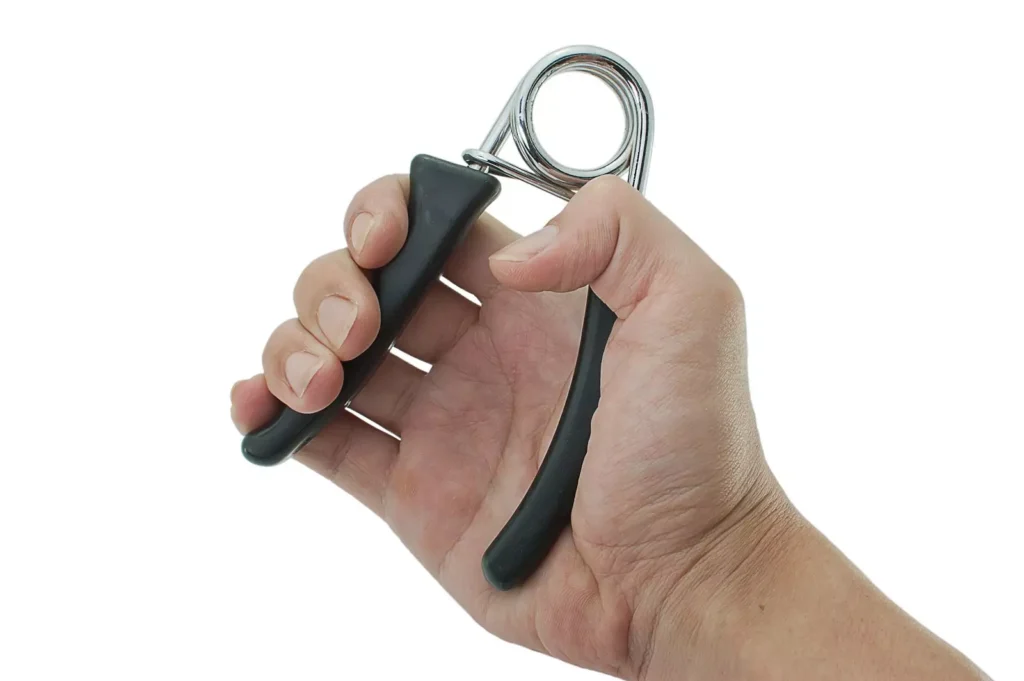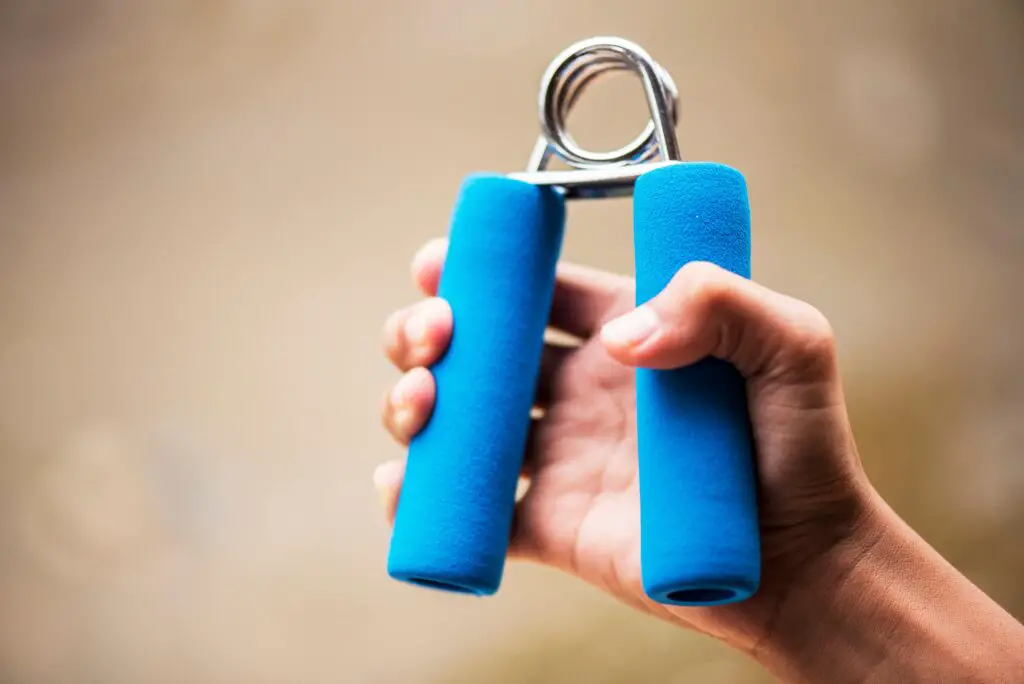Introduction
How To Train Grip Strength With Grippers: In the realm of physical fitness and functional strength, few attributes are as crucial yet often overlooked as grip strength. A formidable grip not only signifies a well-rounded physical prowess but also plays a pivotal role in various day-to-day activities and sports. Whether you’re an athlete aiming to improve performance, a weightlifter seeking to conquer heavier loads, or an individual striving for overall functional fitness, grip strength is a fundamental component that demands attention. Among the myriad techniques and tools available for developing grip strength, gripper training stands out as a tried-and-true method. Grippers, compact handheld devices designed to test and enhance grip strength, offer an efficient and focused approach to training the muscles and tendons responsible for controlling your grip. This form of training not only targets specific muscle groups in the hand and forearm but also provides a means of tracking progress as you work towards achieving tangible strength milestones.
In this guide, we will delve into the art and science of training grip strength with grippers. We’ll explore the underlying anatomy of the hand and forearm, dissect the benefits of a robust grip, and outline the various types of grippers available to cater to different fitness levels. Whether you’re a novice embarking on your journey to fortified hands or a seasoned fitness enthusiast seeking advanced techniques, this guide will provide you with a comprehensive roadmap to unlock the potential of your grip strength. From selecting the right gripper to designing effective training routines and understanding the nuances of proper technique, we will leave no stone unturned in our pursuit of mastering grip strength through gripper training. Prepare to embark on a transformative journey that not only empowers your physical capabilities but also enriches your everyday life with newfound strength and dexterity.
In the dynamic landscape of fitness and athleticism, the importance of grip strength cannot be overstated. Beyond its significance in weightlifting and sports, a robust grip is a cornerstone of functional strength that extends to activities as mundane as carrying groceries or opening jars. Whether you’re an aspiring athlete, a dedicated fitness enthusiast, or simply someone seeking to enhance their everyday capabilities, honing your grip strength can yield a multitude of benefits. Enter gripper training—a targeted and impactful method for developing formidable grip strength. Grippers, compact and portable tools designed specifically for strengthening hand and forearm muscles, provide a focused avenue to cultivate your grip prowess. The journey of mastering grippers not only involves building physical strength but also navigating the mental fortitude required to conquer these challenging devices.

Do grippers increase grip strength?
Whether you’re a high-level athlete or just looking to develop a stronger handshake, using a gripper such as the CoC as a part of your training regimen is a sure-fire way to boost your grip strength.
Grippers are designed to simulate the action of gripping an object with maximal force. When you squeeze a gripper, it places resistance against the muscles responsible for closing your hand. This resistance engages muscles like the flexor digitorum profundus and flexor pollicis longus in the forearm, as well as the muscles of the hand itself. Over time, subjecting these muscles to consistent resistance can lead to muscular adaptations and increased strength.
Similar to any form of strength training, the concept of progressive overload plays a significant role in grip strength development using grippers. Progressive overload involves gradually increasing the resistance or intensity of the training stimulus over time. When training with grippers, starting with a gripper that provides moderate resistance and gradually progressing to stronger grippers as your strength improves is essential.
It’s important to note that while grippers can contribute to grip strength development, they are most effective when used as part of a comprehensive training regimen. Engaging in activities that target different aspects of grip strength, such as supporting grip (holding weights for an extended period) and pinch grip (holding objects between the fingers and thumb), can provide a well-rounded approach to strengthening your grip.
Is it OK to use hand grippers everyday?
To build hand strength and muscle mass, you should use hand grips for at least 24 hours for two weeks. You need to use hand grips at least 2 hours a day in a day. You should use the hand grips regularly for at least six months to see visible changes.
Like any form of physical training, allowing your muscles to recover is crucial for optimal growth and development. When you train with hand grippers, you’re subjecting the muscles of your hand and forearm to resistance, causing tiny muscle fibers to break down. These fibers then repair and strengthen during the recovery phase, leading to improved grip strength over time.
Using hand grippers every day without proper consideration for recovery can lead to overtraining. Overtraining occurs when the body doesn’t have sufficient time to repair and rebuild muscle fibers, potentially resulting in decreased performance, increased risk of injury, and overall fatigue. It’s important to strike a balance between training intensity and recovery.
The frequency at which you can use hand grippers depends on various factors, including your fitness level, the intensity of your workouts, and how well your body responds to training. Novices who are just starting out may find it beneficial to train with hand grippers every other day or two to three times a week. As you progress, you can gradually increase the frequency if your body allows.
What weakens grip strength?
Carpal tunnel syndrome is a common culprit, but shoulder issues, inflammatory conditions including arthritis, and pinched nerves can also contribute to decreased grip strength. That’s why we start with a thorough examination, a review of your symptoms, and an analysis of any imaging tests, such as X-rays.
Age and Muscle Loss
As we age, the natural process of muscle atrophy, known as sarcopenia, can lead to a reduction in muscle mass and strength throughout the body, including the muscles of the hand and forearm. This loss of muscle tissue directly affects grip strength, making it essential to engage in regular strength training to counteract this decline.
Sedentary Lifestyle
A sedentary lifestyle characterized by minimal physical activity can lead to muscle weakening and loss of strength, including grip strength. When the muscles are not regularly engaged in activities that challenge them, they may become weaker over time.
Lack of Physical Activity
Inadequate engagement in physical activities that require grip strength, such as weightlifting, rock climbing, or even regular use of hand tools, can contribute to a decrease in grip strength. Without consistent stimulation, the muscles responsible for grip may not develop to their full potential.
Do hand grippers show veins?
Hand grippers do indeed play a role in developing vascularity, but not without a little help from our good friend, science. You see, when you use hand grippers to work your forearm muscles, you’re also increasing blood flow to those areas. As your muscles grow and blood flow increases, your veins become more visible.
Exercise, particularly strength training, can impact vascularity to some extent. As muscles contract during exercise, blood flow increases to provide oxygen and nutrients to the working muscles. This increased blood flow can cause veins to temporarily expand, making them more visible beneath the skin’s surface. This phenomenon is often referred to as “vascular pump” or “vascular engorgement.”
Grip-strengthening exercises, including the use of hand grippers, can lead to increased blood flow in the hands and forearms, especially during and immediately after training. As a result, veins may become more visible due to the temporary expansion of blood vessels. This effect is often transient and diminishes once the muscles relax and blood flow returns to normal.
The visibility of veins is influenced by genetic factors and individual body composition. Some individuals naturally have more visible veins due to their genetics and lower body fat percentages. However, grip-strengthening exercises themselves are not a direct cause of permanently increased vascularity.
Do grippers increase forearm size?
Grippers are a great way to build your forearm size and strength and offer a unique stimulus compared to other exercises. Lifters should look to use a full range of motion with maximal force and incorporate varying protocols such as drop sets, eccentrics, and isometrics.
Similar to other forms of strength training, progressive overload is a fundamental principle in grip training. To stimulate muscle growth, it’s essential to gradually increase the resistance and intensity of the training stimulus. Starting with grippers of moderate resistance and progressing to stronger ones as your grip strength improves can contribute to forearm muscle development.
While gripper training primarily targets the muscles of the hand and forearm, it’s important to recognize that forearm size can also be influenced by other factors. Compound exercises like deadlifts, pull-ups, and rows engage the muscles of the entire upper body, including the forearms. These exercises can contribute to overall forearm development, complementing the effects of gripper training.
It’s important to acknowledge that individual responses to training can vary based on genetic factors and personal characteristics. Some individuals may experience more noticeable forearm growth from gripper training, while others may see more moderate changes. Genetics play a role in how muscle fibers respond to training stimuli, influencing the potential for muscle hypertrophy (growth).
Is there any disadvantage of using hand gripper?
Though the muscles of the forearm heal quite rapidly, using grip strengtheners on a daily or nearly daily basis can result in overtraining, tendinopathy, and a number of other chronic overuse injuries associated with resistance exercises.
One of the main disadvantages of using hand grippers is the risk of overtraining and injury. Overtraining occurs when you consistently push your muscles beyond their capacity without allowing sufficient time for recovery. This can lead to muscle fatigue, strain, and potentially more serious injuries, such as tendonitis. It’s crucial to listen to your body, avoid excessive training volume, and incorporate rest days to prevent overtraining.
Focusing solely on gripper training can lead to imbalanced forearm development. The muscles of the hand and forearm are complex and multifunctional. Relying solely on grippers may neglect other aspects of grip strength, such as pinch grip and support grip. A well-rounded grip training routine should incorporate various exercises to ensure balanced development.
While gripper training is effective for improving grip strength in the context of squeezing and crushing motions, it may have limited application in activities that require different types of grip strength, such as hanging from a bar or gripping irregular objects. Including diverse grip-strengthening exercises in your routine ensures you’re prepared for various real-world challenges.
Does hand gripper affect height?
The results of this study, showed that anthropometric parameters like weight, height were positively correlated with hand grip muscle strength and height positively correlated with muscle endurance.
Height is primarily determined by genetic factors. Genetics play a significant role in dictating the potential height an individual can reach. The human growth process is governed by the growth plates located at the ends of long bones. During puberty, these growth plates undergo a process called ossification, where they close and stop allowing for bone growth. This is why individuals experience the most significant height growth during their teenage years.
Hand grippers are specifically designed to strengthen the muscles of the hand and forearm by providing resistance during gripping exercises. While gripper training can lead to enhanced grip strength and forearm development, it has no direct influence on the growth plates or bone lengthening that contribute to height growth.
The idea that using hand grippers can affect height is a misconception that likely stems from misinformation or a misunderstanding of human growth processes. Height growth is a complex biological process influenced by a variety of factors, including genetics, nutrition, hormonal changes, and overall health. Engaging in grip-strengthening exercises such as using hand grippers will not cause changes in height beyond what is determined by genetics and normal growth processes.
Do hand grippers build forearms?
Your forearm flexors and extensors are the muscles which control the opening and closing of your fingers. These are the main muscles working when using hand grips, so if you’re looking to build muscular looking forearms, as well as a mighty strong grip, hand grips are definitely a good choice for you.
Hand gripper training engages several muscles in the hand and forearm. When you squeeze a gripper, muscles such as the flexor digitorum profundus, flexor carpi radialis, and brachioradialis are recruited to generate the gripping force. These muscles are responsible for flexing the fingers, wrist, and forearm. As you repeatedly use hand grippers, these muscles experience tension and microtrauma, leading to muscle adaptation and growth.
The concept of progressive overload applies to hand gripper training just as it does to other forms of strength training. Progressive overload involves gradually increasing the resistance or intensity of the training stimulus over time. Starting with grippers of moderate resistance and progressing to stronger ones ensures that your muscles are consistently challenged, promoting muscle growth (hypertrophy) in the forearms.
Hand grippers primarily target the muscles involved in gripping and crushing motions. While these exercises are effective for developing specific forearm muscles, it’s important to note that the forearms comprise various muscle groups responsible for different types of grip strength, such as pinch grip and support grip. Incorporating a variety of grip-strengthening exercises in your routine can lead to comprehensive forearm development.

Conclusion
The benefits of grip strength extend to both athleticism and daily activities, underlining the importance of your efforts. Whether it’s conquering heavier lifts, excelling in sports, or simply navigating everyday tasks with ease, your fortified grip will play a pivotal role in your success. As you continue your journey, remember that progress is not always linear. Plateaus and challenges are natural companions on the road to mastery. Embrace them as opportunities to refine your approach, adjust your training, and persevere with unwavering determination. Gripper training has equipped you with a tangible measure of progress, allowing you to witness firsthand the results of your dedication. As you set new personal records and witness the growth of your grip strength, let these achievements fuel your motivation to reach even greater heights. Ultimately, your journey with grippers transcends the physical realm, instilling discipline, focus, and resilience. The lessons learned while squeezing those unyielding devices are reflections of your own growth as an individual.
With a powerful grip in your arsenal, you’re poised to face challenges with confidence and embrace opportunities with a firm grasp. So, as you stand at the crossroads of accomplishment and potential, carry forward the wisdom you’ve gained and the strength you’ve cultivated. With every squeeze, you’ve not only fortified your grip but also solidified your commitment to self-improvement. Let your enhanced grip strength serve as a constant reminder of your capability to shape your own destiny—one grip at a time. Your voyage into the world of grippers has revealed that the strength of your grip is a microcosm of your overall resilience. It’s a reflection of your willingness to push boundaries, embrace challenges, and adapt to the demands of your aspirations. With each incremental improvement in grip strength, you’ve also cultivated mental fortitude—a quality that translates into other facets of your life, fostering growth and self-assurance.
The versatility of grip strength’s application cannot be overstated. From athletics to daily tasks, your newly acquired grip prowess will serve as a cornerstone of your capabilities. Lifting heavier weights, mastering sports, and accomplishing everyday tasks with ease are all within your grasp, no pun intended. As you chart your course beyond these words, remember that progress is a journey of peaks and valleys. Plateaus are merely stepping stones to breakthroughs, and setbacks are opportunities to recalibrate and emerge stronger. The dedication you’ve displayed in your gripper training is a testament to your commitment to self-improvement—an attribute that will continue to serve you well.
In the tapestry of your journey, grip strength is not just a measure of physical might, but a symbol of your indomitable spirit. Keep gripping, keep striving, and keep evolving, for your journey with grippers is a perpetual reminder that within you lies the power to shape your own destiny, one grip at a time.

